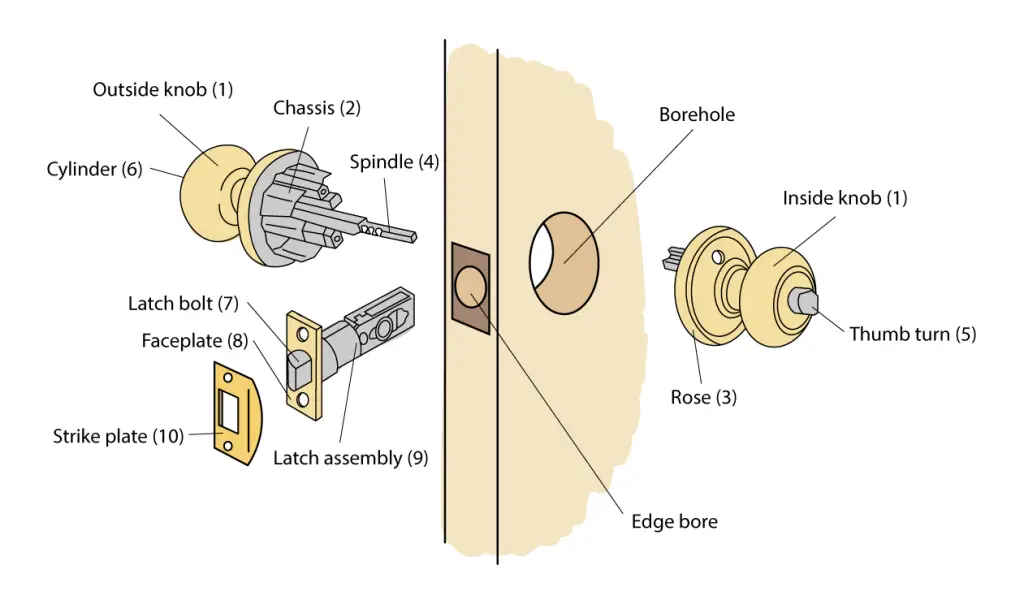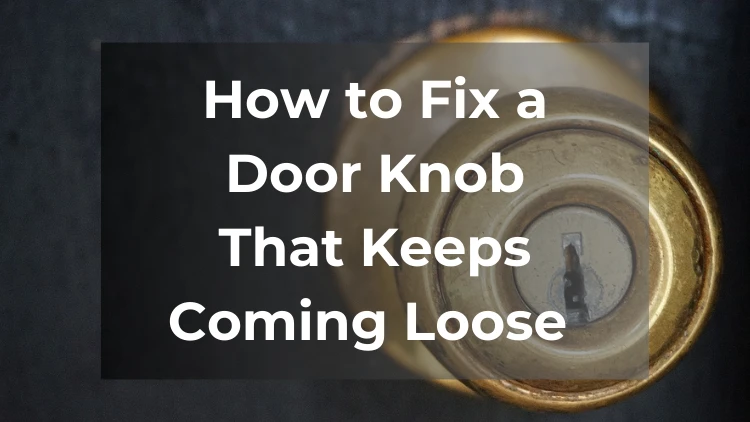A loose door knob can be a real nuisance. It’s also a safety hazard.
Fixing a loose knob is an easy DIY project that usually takes less than 30 minutes. With a few basic tools and materials, you can tighten up a stubborn knob and get your door opening smoothly once again.
Identifying the Cause of the Loose Door Knob
Before attempting to fix a loose knob, it’s important to understand why it may be loose in the first place.
There are two main types of door knobs: exposed set-screw and hidden screw.
Exposed set-screw knobs have one or more screws on the base of the knob that hold it to the spindle. Hidden screw knobs have no visible screws, but instead have a small slot or hole on the side of the knob that allows you to access the screw inside.
To identify the type of your door knob, look at the base of the knob and see if there are any screws. If there are, you have an exposed set-screw knob. If not, you have a hidden screw knob.
The most common cause of a loose door knob is that the screws are loose or missing.
Checking the Screws
If you have an exposed set-screw knob:
- simply tighten the screws with a screwdriver until they are snug
- do not over-tighten them, as this can damage the knob or the spindle
If you have a hidden screw knob:
- you will need to use a small flat-head screwdriver or a paper clip to push the slot or hole on the side of the knob and release the knob from the spindle
- then, you can tighten the screw inside the knob with the screwdriver
Checking the Spindle
Another possible cause of a loose door knob is that the spindle is worn out or broken.
The spindle is the metal rod that connects the two knobs on either side of the door. If the spindle is loose or damaged, it can cause the knobs to wobble or fall off.

You’ll find the different parts of a door knob here (with illustration and explanation).
To check the spindle, you will need to remove both knobs from the door.
If you have an exposed set-screw knob, simply loosen the screws and pull the knobs off the spindle.
If you have a hidden screw knob, use the same method as above to release the knobs from the spindle. Then, inspect the spindle for any signs of wear or damage, such as cracks, bends, or rust.

Tools and Materials Needed
Depending on the cause and type of your loose door knob, you will need different tools and materials to fix it.
Here is a list of the most common ones:
- Screwdriver (Phillips or flat-head, depending on the type of screws)
- Small flat-head screwdriver or paper clip (for hidden screw knobs)
- New screws (if the old ones are missing or stripped)
- New spindle (if the old one is worn out or broken)
- New door knob (if the old one is damaged or you want to replace it)
- Locking pliers (if the spindle is stuck in the knob)
- Hammer (if the spindle is bent)
- WD-40 or other lubricant (if the spindle is rusty or squeaky)
Having these tools on hand before getting started with the repair will make the job go smoothly.
Step-by-Step Guide on How to Fix a Loose Door Knob
Follow these steps to securely tighten a door knob that keeps coming loose:
- Remove the door knob. If you have an exposed set-screw knob, loosen the screws and pull the knob off the spindle. If you have a hidden screw knob, use a small flat-head screwdriver or a paper clip to push the slot or hole on the side of the knob and release it from the spindle. Set the knob aside.
- Tighten interior screws. Use the screwdriver to tighten any loose screws anchoring the interior mechanism. Tighten snugly, but be careful not to strip the heads. If the screws are missing, replace them with new ones.
- Check the spindle and replace it if needed. If the spindle is worn out or broken, replace it with a new one that matches the size and shape of the old one. If the spindle is stuck in the knob, use locking pliers to grip it and pull it out. If the spindle is bent, use a hammer to straighten it. If the spindle is rusty or squeaky, put a few drops of WD-40 or other lubricant on it and wipe it with a cloth.
- Reattach door knob to the door. If you have an exposed set-screw knob, slide the knob onto the spindle and tighten the screws. If you have a hidden screw knob, slide the knob onto the spindle and use the small flat-head screwdriver or paper clip to push the slot or hole on the side of the knob and lock it in place.
- Test knob. Open and close the door a few times to check tightness. If the knob is still loose, you should try the troubleshooting tips below.
Troubleshooting Tips
If you followed the steps above and still have a loose door knob, here are some tips to help you troubleshoot the problem:
- Make sure you have aligned the knob and the spindle correctly. The knob and the spindle should fit snugly and have matching holes or slots for the screws or the locking mechanism.
- Make sure you have not overtightened or undertightened the screws. Overtightening can strip the screws or damage the knob or the spindle. Undertightening can cause the knob to wobble or fall off.
- Make sure you have not damaged the knob or the spindle while removing or reattaching them. If the knob or the spindle is cracked, chipped, or dented, it can affect the stability and functionality of the door knob.
- Make sure you have not installed the knob or the spindle upside down or backwards. The knob and the spindle should have the same orientation and direction as before. If not, they can interfere with the locking mechanism or the latch.
- Check alignment. If the knob and strike plate don’t line up well, use wood shims to adjust the door position in frame. Sand or file plate if needed.
When to Replace the Knob
If attempts to tighten the existing knob fail to fix looseness or rattling, it’s time to replace the knob completely.
Some signs that replacement is needed:
- Internal components damaged or too worn to tighten properly.
- Rust or corrosion that cannot be cleaned from the knob exterior.
- Missing, broken, or stripped screws that cannot be replaced.
- Loose knob on exterior doors that have been exposed to weather.
- Latch bolt so worn it does not catch securely, even when aligned properly.
- Excessive wobble or movement when the knob is supposedly tight.
Replacement knobs start around $10 for basic models, and full installation can be done in under an hour. If your door knob keeps coming loose over and over again, you should consider installing a new knob to save the hassle of repeated repairs.
Related: How to Properly Measure for New Door Knob and Handle
When to Call a Professional
While a simple loose knob is an easy DIY fix, some situations may require a professional:
- You are not comfortable or confident with doing it yourself.
- You have a complex or specialized door or lock.
- Door alignment is badly out of square, requiring major adjustments.
- Knob holes are badly damaged and require filling and redrilling.
- Latch plate is recessed and difficult to access.
- Knobs on exterior doors so weathered the lock cylinder is seized up.
- Doors that fail to latch properly due to major warping or settlement.
- You have other serious or persistent problems.
For major door damage or alignment issues beyond strike plate adjustment, a carpenter may be needed. And locks that require disassembly should be handled by a locksmith.
Prevention
To minimize the chance of having loose knobs in the future:
- Periodically tighten screws on knobs that get frequent use.
- Lubricate latch bolts with powdered graphite or silicone spray.
- Ensure doors are properly aligned in their frames, shimming if necessary during installation.
- Use longer screws on exterior doors, and tighten screws fully.
- Consider higher quality knobs for exterior doors subject to weather.
- Install reinforcements like wraparound strike plates to strengthen the door jamb.
- Keep doors properly sealed and protected from moisture to prevent warping.
With careful installation and periodic maintenance, most knobs should remain tight for years before needing repairs. But even the best knob will work loose over time. Follow these tips and tightening a loose knob will be a quick, easy fix.











